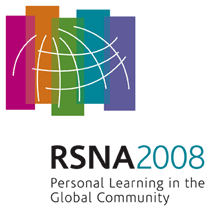
Abstract Archives of the RSNA, 2008
SSQ01-04
Application of DWI in Pathological Response Evaluation of Patients with Breast Cancer after Neoadjuvant Chemotherapy: A Preliminary Study
Scientific Papers
Presented on December 4, 2008
Presented as part of SSQ01: ISP: Breast Imaging (MR Imaging Techniques)
Xiaopeng Zhang MD, Abstract Co-Author: Nothing to Disclose
Jie Li, Presenter: Nothing to Disclose
Lei Tang MD, Abstract Co-Author: Nothing to Disclose
Yong-kun Chi, Abstract Co-Author: Nothing to Disclose
To investigate the association of signal intensity and ADC value of residual disease in DWI with pathological response status in patients of breast cancer after neoadjuvant chemotherapy.
MRI was performed on 63 breast cancer patients who finished neoadjuvant chemotherapy with a 1.5T scanner and dedicated breast coil. Axial Diffusion-weighted imaging were performed by single-shot EPI sequence, with b value of 1000s/mm2. Abnormal signal of residual disease in DWI was identified in the reference of axial contrast enhanced images, and signal intensity was classified into 3 categories by visual inspection: extremely high, mildly high and isointensity. ADC value was acquired by putting ROI in lesion with abnormal signal at workstation. All the patients had operation, and the pathological response were determined by a pathologist as Pathological Complete Response (pCR) or pathological Invasive disease ( p INV), and Major Histological Response (MHR), or non MHR. Correlation analysis between contrast intensity and histopathological response was performed and ADC in MHR and non MHR group was compared statistically.
Eight cases with pCR and 36 cases with MHR by histological evaluation were acquired. The contrast intensity of residua lesion in diffusion weighted images were as follows: extremely high in 23 cases (36.5%), mildly high in 24 cases (38.1%) and isodensity in 16 cases (25.4%). Of 8 pCR cases, 7 (87.5%) were isodensity in DWI, 1 was mildly high intensigy. DWI had 83.6% (46/55) sensitivity and 87.5% (7/8)specificity for diagnosis of residual invasive cancer. In 36 cases of MHR, 13 is isointensity (13/16, 81.3%), 17 is mildly high intensity (17/24, 70.8%), and only 6 cases is extremely high (6/23, 26.1%). The difference of signal intensity between MHR and non MHR pathological groups was statistically significant (χ2=14.7, P=0.001). The ADC value of cases with abnormal signal was 0.00133±0.00025 mm2/s in MHR and 0.00139±0.00024mm2/s in non MHR group,which showed no statistical difference(P>0.05).
DWI is helpful to evaluated pathological response of breast cancer after chemotherapy. The signal intensity in diffusion weighed image could be a valuable predicting indicator.
DWI may has a potiential role to evaluate pathological response status of residual disease in patient with breast cancer after neoadjuvant chemtherapy.
Zhang, X,
Li, J,
Tang, L,
Chi, Y,
Application of DWI in Pathological Response Evaluation of Patients with Breast Cancer after Neoadjuvant Chemotherapy: A Preliminary Study. Radiological Society of North America 2008 Scientific Assembly and Annual Meeting, February 18 - February 20, 2008 ,Chicago IL.
http://archive.rsna.org/2008/6018756.html

